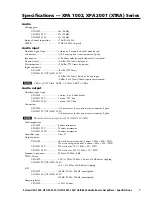
SETUP MENU
Bass
Treble
Balance
}Setup
}Equalization
Polarity
Listening Mode
Speaker Compensation
Pre Out/Subwoofer
Soft Clipping
IR Channel
}Source Setup
The Setup menu consists of the following selectable and adjustable
parameters – Equalization, Polarity, Listening Mode, Speaker Compensation,
Pre Out/Subwoofer, Soft Clipping, IR Channel and Source Setup.
EQUALIZATION/ROOM EQ
Equalization
}Room EQ
The ROOM EQ feature of the C 390DD is a simple and effective way to tame
standing waves without altering the upper frequency balance of your
loudspeakers.
Imagine a stone dropped into a small pool of water: waves ripple along
the surface in concentric circles until they reach the boundary of the pool,
at which time they are reflected back toward the point where the stone
entered the water. As the reflected wave travels back, it interacts with
the primary waves, causing a pattern of interference. Depending on the
spacing (frequency) of the waves, some will be nulled and some will be
reinforced or doubled in size. In the listening room, a similar pattern of
sound wave nulling or cancellation and sound wave reinforcement also
takes place.
The proximity of stereo loudspeakers to the listening room boundaries
creates “sound reflections” that almost always result in uneven frequency
response at the listening position.
At higher frequencies these reflections can be absorbed and scattered
randomly by the surface textures of wall coverings, drapes and furniture in
the room. But at the lower frequencies, the wave lengths are very large and
they interact with the room boundaries to create “standing waves” that can
alter the sound of music.
ROOM EQ TEST SEQUENCE
Our simple solution to this “standing waves” is the Room EQ. We have
devised a very simple test sequence to make the adjustments by ear (or
using an SPL meter). It uses the same concept musicians use to tune a
stringed instrument, with a slight twist: instead of matching frequency or
pitch, we are matching loudness levels.
Playing back the ROOM EQ TEST SEQUENCE allows this problem to be easily
tamed using your ears and the C 390DD Room EQ filters. The following are
the adjustable parameters.
}Freq Level EQ
40Hz 0dB Narrow
Frequency:
There are six filters available in the frequency range where
standing waves typically are a problematical: 40Hz, 60Hz, 90Hz, 120Hz,
180Hz and 240Hz.
Level:
The 6 frequency centers in the low bass region can be cut or
slightly boosted to remove the “boom” without reducing the low bass
response. Each filter can be boosted by up to 4dB or cut by up to 12dB in
2dB increments. The reason there is a smaller amount of boost than cut is
because boosting a null frequency actually increases the null making the
problem worse. Fortunately, the ear is less sensitive to sound missing than it
is to sound added. The objective is to tame the “boom” in the bass, resulting
to a much more incisive and realistic sound.
EQ:
The width or “Q” of the filter can also be adjusted to be wide or narrow
to address a number of different room configurations.
IMPORTANT NOTE
The “Room EQ Test Sequence” file along with corresponding instructions
can be downloaded via the NAD website link –
http://nadelectronics.
com/products/hifi-amplifiers/C-390DD-Direct-Digital-Powered-DAC-
Amplifier
. Follow the instructions provided with the “Room EQ Test
Sequence” package.
POLARITY
Polarity
}~Positive
`Reversed
Allow compensation for recordings that have reversed polarity.
Positive:
A positive sine wave at the input remains positive at the
output. Polarity is defaulted to “Positive” setting.
Reversed:
A positive sine wave at the input is negative (inverted) or
reversed at the output.
OPERATION
USING THE C 390DD
15
ENGLISH
FR
ANÇ
AIS
ESP
AÑOL
IT
ALIANO
DEUT
SCH
NEDERL
ANDS
SVENSK
A
РУ
ССКИЙ










































